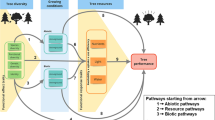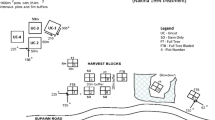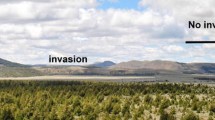Abstract
Concern about forestry practices creating tree-level monoculture plantations exists. Our study investigates tree diversity responses for six early seral boreal forest plantations in Ontario, Canada, representing three conifer species; black spruce (Picea mariana), white spruce (P. glauca), and jack pine (Pinus banksiana), 14 release treatments, and 94 experimental units. Dominance-diversity curves and Simpson’s indices of diversity and evenness indicate tree alpha diversity. We propose a new method for assessing diversity, using percentage of theoretical species maximum (%TSM) which is determined by comparing post-disturbance richness (S) with a theoretical species maximum (TSM). Our results support the hypothesis that alternative vegetation release treatments generally do not reduce tree species diversity levels (%TSM) relative to untreated plots. The only %TSM (P ≤ 0.05) comparison that produced less diversity than in control plots was repeated annual treatments of Vision herbicide at one of the black spruce study sites. Our results generally support the hypothesis that tree monocultures do not develop after vegetation release. Only one out of 94 experimental units developed into a tree layer monoculture (Simpson’s reciprocal diversity index = 1). Again this was one of the repeated annual treatments of Vision herbicide at one of the black spruce study sites—a treatment which is atypical of Canadian forest management.



Similar content being viewed by others
Notes
We used the Forest Science database keyword search, searching all fields, limiting search to “Journal Articles” from “09/2005 to 1939” for the basis of this claim. Query 1 = (boreal) = 5,038 records, and Query 2 = (boreal) and ((tree biodiversity) or (tree diversity) or (tree species richness)) = 5 records. Of the articles with keyword “boreal” only 0.1% met our “tree diversity” search criteria (Source: Forest Sciences Database. 1997–2005 WebSPIRS. Ovid Technologies. Version 5.1. Build 20050721).
References
Allaby M (ed) (1998) A dictionary of ecology, 2nd edn. New York Oxford Univ. Press, New York, NY, p 440
Archibold OW, Acton C, Ripley EA (2000) Effect of site preparation on soil properties and vegetation cover, and the growth and survival of white spruce (Picea glauca) seedlings, in Saskatchewan. For Ecol Manage 131:127–141
Bell FW, Newmaster SG (2002) The effects of silvicultural disturbances on the diversity of seed-producing plants in the boreal mixedwood forest. Can J For Res 32:1180–1191
Bell FW, Lautenschlager RA, Wagner RG, Pitt DG, Hawkins JW, Ride KR (1997) Motor-manual, mechanical, and herbicide release affect early successional vegetation in northwestern Ontario. For Chron 73:61–68
Bell FW, Pitt DG, Wester MC (2006) Is intensive forest management a misnomer? An Ontario-based discussion of terminology and an alternative approach. For Chron 82(5):662–674
Betts MG, Diamond AW, Forbes GJ, Frego K, Loo JA, Matson B, Roberts MR, Villard M, Wissink R, Wuest L (2005) Plantations and biodiversity: a comment on the debate in New Brunswick. For Chron 81:265–269
Boateng JO, Haeussler S, Bedford L (2000) Boreal plant community diversity 10 years after glyphosate treatment. West J Appl For 15:15–26
Boyle TJB (1992) Biodiversity of Canadian forests – current status and future challenges. For Chron 68:444–453
Brundtland GH (1987) Our common future. World Commission on Environment and Development. Oxford University Press, New York, NY, p 383
Burton PJ, Balisky AC, Coward LP, Cumming SG, Kneeshaw DD (1992) The value of managing for biodiversity. For Chron 68:225–237
Carnus J-M, Parrotta J, Brockerhoff E, Arbez M, Jactel H, Kremer A, Lamb D, O’Hara K, Walters B (2006) Planted forests and biodiversity. J For 104(2):65–77
Centre for International Forestry Research CIFOR (2002) CIFOR infobrief: typology of planted forests. Centre for International Forest Research, Bogor Barat, Indonesia, p 4
Chen HYH, Popadiouk RV (2002) Dynamics of North American boreal mixedwoods. Environ Rev 10:137–166
Dampier J, Bell FW, St-Amour M, Pitt DG, Luckai NJ (2006) Cutting versus herbicides: tenth-year volume and release cost effectiveness of sub-boreal conifer plantation. For Chron 82(4):521–528
Droege S, Cyr A, Larivee J (1998) Checklists: an under-used tool for the inventory and monitoring of plants and animals. Conserv Biol 12:1134–1138
Dunster J, Dunster K (1996) Dictionary of natural resource management. UBC Press, Vancouver, BC
Environment Canada (1995) Canadian biodiversity strategy: Canada’s response to the convention on biological diversity. Biodiv. Conv. Office Environ. Can., Hull, PQ, p 80
Erdle T, Pollard J (2002) Are plantations changing the tree species composition of New Brunswick’s forest? For Chron 78:812–821
Esseen PA, Ehnström B, Ericson L, Sjöberg K (1997) Boreal forests. Ecol Bull 46:16–47
Farrar JL (1995) Trees in Canada. Fitzhenry & Whiteside Limited and Natural Resources Canada, Ottawa, ON, p 502
Forestry Research Partnership FRP (2005) Old trial measurement for intensive forest management practices (Living Legacy Funding Program 4). For. Res. Partner., Mattawa, ON. http://www.forestresearch.ca/partnership_projects/fibre_production/Old%20Trial%20Remeasuremennt%20Summaries.htm. Accessed 12 Jan 2006
Hunt SL, Gordon AM, Morris DM, Marek GT (2003) Understory vegetation in northern Ontario jack pine and black spruce plantations: 20-year successional changes. Can J For Res 33:1791–1803
Johnson EA, Morin H, Miyanishi K, Gagnon R, Greene DF (2003) A process approach to understanding disturbance and forest dynamics for sustainable forestry. In: Burton PJ, Messier C, Smith DW, Adamowicz WL (eds) Towards sustainable management of the Boreal Forest. NRC Res. Press, Ottawa, ON, pp 261–306
Lande R (1996) Statistics and partitioning of species diversity, and similarity among multiple communities. Oikos 76:5–13
Landres PB, Morgan P, Swanson FJ (1999) Overview of the use of natural variability concepts in managing ecological systems. Ecol Appl 9:1179–1188
Magurran AE (1988) Ecological diversity and its measurement. Croom Helm, London, England, p 179
Mallik AU, Bell FW, Gong YL (2002) Effectiveness of delayed brush cutting and herbicide treatments for vegetation control in a seven-year-old jack pine plantation in northwestern Ontario, Canada. Silva Fenn 36:505–519
May E (2005) At the cutting edge: the crisis in Canada’s forests. Key Porter Books, Toronto, ON, p 432
Mosquin T, Whiting PG, McAllister DE (1995) Canada’s biodiversity: the variety of life, its status, economic benefits, conservation costs and unmet needs. Canadian Museum of Nature, Ottawa, ON, p 293
Natural Resources Canada NRCan (2004) The state of Canada’s forests 2003–2004. Nat. Resour. Can., Ottawa, ON, p 94
Newmaster SG, Bell FW, Roosenboom CR, Cole HA, Towill WD (2006) Restoration of floral diversity through plantations on abandoned agricultural land. Can J For Res 36:1218–1235
Ontario Forest Accord Advisory Board OFAAB (2002) Room to grow: final report of the Ontario forest accord advisory board on implementation of the accord. Ont. Min. Nat. Resour., Sault Ste. Marie, ON, p 28
Ontario Ministry of Natural Resources OMNR (2004) Provincial wood supply strategy. Ont. Min. Nat. Resour., Toronto, ON, p 92
Ontario Ministry of Natural Resources OMNR (2005) Protecting what sustains us: Ontario’s biodiversity strategy 2005. Ont. Min. Nat. Resour., Toronto, ON, p 44
Payne LX, Schindler DE, Parrish JK, Temple SA (2005) Quantifying spatial pattern with evenness indices. Ecol Appl 15:507–520
Pielou EC (1975) Ecological diversity. John Wiley & Sons, New York, NY, p 165
Pitt DG, Morneault AE, Bunce P, Bell FW (2000) Five years of vegetation succession following vegetation management treatments in a jack pine ecosystem. N J Appl For 17:100–109
Pitt DG, Wagner RG, Towill WD (2004) Ten years of vegetation succession following ground-applied release treatments in young black spruce plantations. N J Appl For 21:123–134
Rees DC, Juday GP (2002) Plant species diversity on logged versus burned sites in central Alaska. For Ecol Manage 155:291–302
Reich PB, Bakken P, Carlson D, Frelich LE, Friedman SK, Grigal DF (2001) Influence of logging, fire, and forest type on biodiversity and productivity in southern boreal forests. Ecology 82:2731–2748
Ricketts TH, Dinerstein E, Olson DM, Loucks CJ, Eichbaum W, DellaSala D, Kavanagh K, Hedao P, Hurley PT, Carney KM, Abell R, Walters S (1999) Terrestrial ecoregions of North America: a conservation assessment. Island Press, Washington, DC, p 485
Rudolph TD, Laidly PR (1990) Pinus banksiana Lamb. jack pine. In: Burns RM, Honkala BH (eds) Silvics of North America: Volume 1 Conifers. Forest Service, USDA Washington, DC, pp 280–293
Sauvageau F (1995) Silvicultural terms in Canada, 2nd edn. Minister of Natural Resources, Hull, PQ, p 109
Secretariat of the Convention on Biological Diversity SCBD (2005) Handbook of the convention on biological diversity including its Cartagena protocol on biosafety, 3rd edn. Montreal, PQ, p 1493
Sims RA, Towill WD, Baldwin KA, Wickware GM (1989) Field guide to the forest ecosystem classification for Northwestern Ontario. Ont. Min. Nat. Resour., Northwest Sci. & Technol., Thunder Bay, ON, p 191
Smith B, Wilson JB (1996) A consumer’s guide to evenness indices. Oikos 76:70–82
Statutes of Ontario (1995) Crown forest sustainability act. Min. Gov. Serv. & Min. Attorn. Gen., Toronto, ON. http://www.e-laws.gov.on.ca/DBLaws/Statutes/English/94c25_e.htm. 23 Jul 2005
Taylor KC, Arnup RW, Merchant BG, Parton WJ, Nieppola J (2000) A field guide to the forest ecosystems of Northeastern Ontario. NEST FG-001, 2nd edn. Ont. Min. Natur. Resour., Northeast Sci. & Technol., South Porcupine, ON, p 325
Terradas J, Salvador R, Vayreda J, Lloret R (2004) Maximal species richness: an empirical approach for evaluating woody plant forest biodiversity. For Ecol Manage 189:241–249
Thompson I.D. (2000) Forest vegetation of Ontario: factors influencing landscape change. In: Perera AH, Euler DL, Thompson ID (eds) Ecology of a managed terrestrial landscape. UBC Press, Vancouver, British Columbia, pp 30–53
Thompson ID, Baker JA, Ter-Mikaelian M (2003) A review of the long-term effects of post-harvest silviculture on vertebrate wildlife, and predictive models, with an emphasis on boreal forests in Ontario, Canada. For Ecol Manage 177:441–469
Thorpe JP (1992) Patterns of diversity in the boreal forest. In: Kelty MJ (ed) The ecology and silviculture of mixed-species forests. Kluwer Academic Publishers, Dordrecht, The Netherlands, pp 65–79
Viereck LA, Johnston WF (1990) Picea mariana (Mill.) B.S.P. black spruce. In: Burns RM, Honkala BH (eds) Silvics of North America: Volume 1 Conifers. Forest Service, USDA Washington, DC, pp 227–237
Wagner RG, Buse LJ, Lautenschlager RA, Bell FW, Holdstedt C, Strobl S, Morneault A, Lewis W, Ter-Mikaelian MT (1995) Vegetation management alternatives program: annual report 1994–95. Ont. Min. Nat. Resour., Ont. For. Res. Inst., Sault Ste. Marie, ON, p 99
White PS, Walker JL (1997) Approximating nature’s variation: selecting and using reference information in restoration ecology. Restor Ecol 5:338–349
Zar JH (1984) Biostatistical analysis, 4th edn. Prentice-Hall, Berkley, CA
Acknowledgements
The collection of data used in this study was sponsored by the Ontario Ministry of Natural Resources (OMNR), Forestry Research Partnership (CEC-FRP), Living Legacy Trust (LLT), Upper Lakes Environmental Research Network (ULERN), and Spray Efficacy Research Group (SERG) members: specifically the Manitoba Department of Natural Resources and Forest Protection Limited (FPL). Financial support for data analysis was provided by the Natural Sciences and Engineering Research Council of Canada (NSERC), Monsanto Canada, Inc., and Forestry Futures Trust Enhanced Forest Productivity Science Program (FFT-EFPS). The projects used in this study were established under OMNR’s Vegetation Management Alternatives Program (VMAP). The authors greatly appreciate the efforts of John Winters and Amy Bolduc and the many folks involved in the field assessments. The authors appreciate technical advise provided by R. Maki, Monsanto Canada, Inc. Editorial and technical advice on an earlier draft was provided by P. Comeau (University of Alberta), D. Pitt (NRCan), J. Winters, A. Morneault, and L. Buse (OMNR) and two anonymous reviewers. The lead author also thanks Mark Lesser, University of Wyoming, for stimulating conversations related to this study and for assistance in producing Fig. 1.
Author information
Authors and Affiliations
Rights and permissions
About this article
Cite this article
Dampier, J.E.E., Luckai, N., Bell, F.W. et al. Do tree-level monocultures develop following Canadian boreal silviculture? Tree-level diversity tested using a new method. Biodivers Conserv 16, 2933–2948 (2007). https://doi.org/10.1007/s10531-007-9151-0
Received:
Accepted:
Published:
Issue Date:
DOI: https://doi.org/10.1007/s10531-007-9151-0




